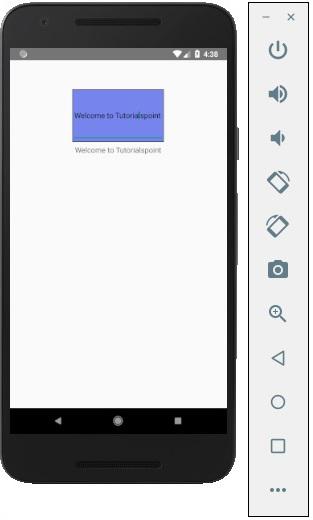React Native - Quick Guide
React Native - Overview
For better understanding of React Native concepts, we will borrow a few lines from the official documentation −
React Native lets you build mobile apps using only JavaScript. It uses the same design as React, letting you compose a rich mobile UI from declarative components. With React Native, you don't build a mobile web app, an HTML5 app, or a hybrid app; you build a real mobile app that's indistinguishable from an app built using Objective-C or Java. React Native uses the same fundamental UI building blocks as regular iOS and Android apps. You just put those building blocks together using JavaScript and React.
React Native Features
Following are the features of React Native −
React − This is a Framework for building web and mobile apps using JavaScript.
Native − You can use native components controlled by JavaScript.
Platforms − React Native supports IOS and Android platform.
React Native Advantages
Follow are the advantages of React Native −
JavaScript − You can use the existing JavaScript knowledge to build native mobile apps.
Code sharing − You can share most of your code on different platforms.
Community − The community around React and React Native is large, and you will be able to find any answer you need.
React Native Limitations
Following are the limitations of React Native −
React Native - Environment Setup
There are a couple of things you need to install to set up the environment for React Native. We will use OSX as our building platform.
Step 1: Install create-react-native-app
After installing NodeJS and NPM successfully in your system you can proceed with installation of create-react-native-app (globally as shown below).
C:\Users\Howcodex> npm install -g create-react-native-app
Step 2: Create project
Browse through required folder and create a new react native project as shown below.
C:\Users\Howcodex>cd Desktop
C:\Users\Howcodex\Desktop>create-react-native-app MyReactNative
After executing the above command, a folder with specifies name is created with the following contents.
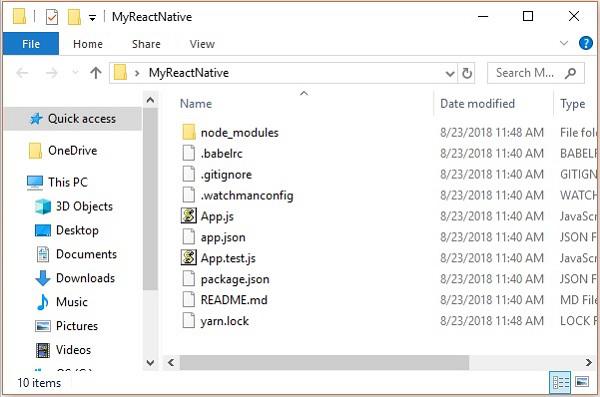
Step 3: NodeJS Python Jdk8
Make sure you have Python NodeJS and jdk8 installed in your system if not, install them. In addition to these it is recommended to install latest version of yarn to avoid certain issues.
Step 4: Install React Native CLI
You can install react native command line interface on npm, using the install -g react-native-cli command as shown below.
npm install -g react-native-cli

Step 5: Start react native
To verify the installation browse through the project folder and try starting the project using the start command.
C:\Users\Howcodex\Desktop>cd MyReactNative
C:\Users\Howcodex\Desktop\MyReactNative>npm start
If everything went well you will get a QR code as shown below.
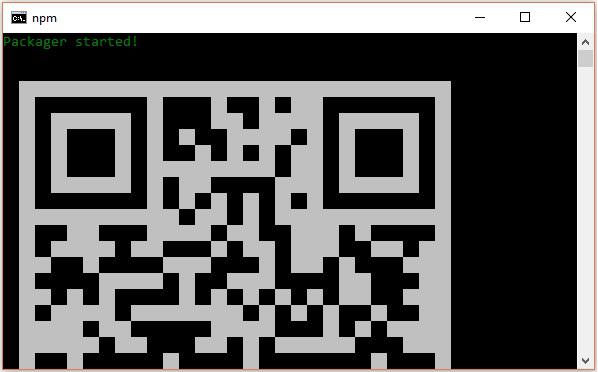
As instructed, one way to run react native apps on your android devise is to using expo. Install expo client in your android devise and scan the above obtained QR code.
Step 6: Eject the project
If you want to run android emulator using android studio, come out of the current command line by pressing ctrl+c.
Then, execute run eject command as
npm run eject
This prompts you options to eject, select the first one using arrows and press enter.

Then, you should suggest the name of the app on home screen and project name of the Android studio and Xcode projects.

Though your project ejected successfully, you may get an error as −
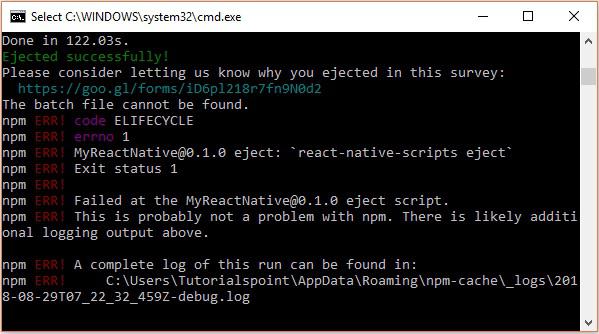
Ignore this error and run react native for android using the following command −
react-native run-android
But, before that you need to install android studio.
Step 7: Installing Android Studio
Visit the web page https://developer.android.com/studio/ and download android studio.

After downloading the installation file of it, double click on it and proceed with the installation.
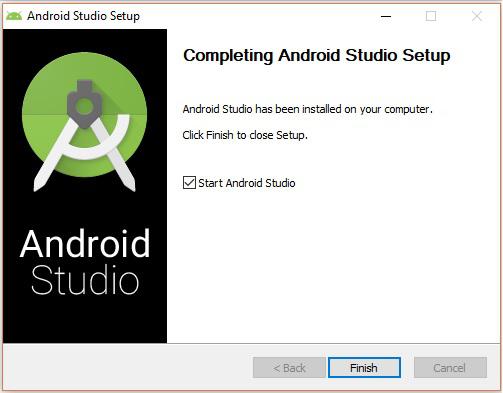
Step 8: Configuring AVD Manager
To configure the AVD Manager click on the respective icon in the menu bar.
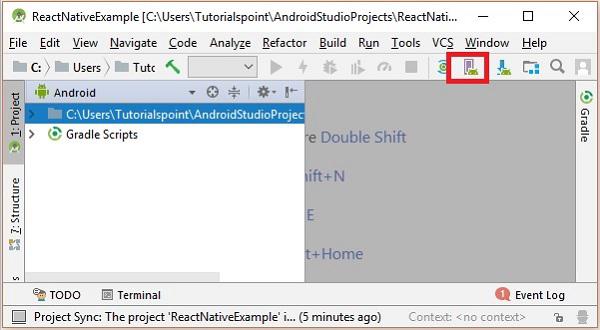
Step 9: Configuring AVD Manager
Choose a device definition, Nexus 5X is suggestable.

Click on the Next button you will see a System Image window. Select the x86 Images tab.
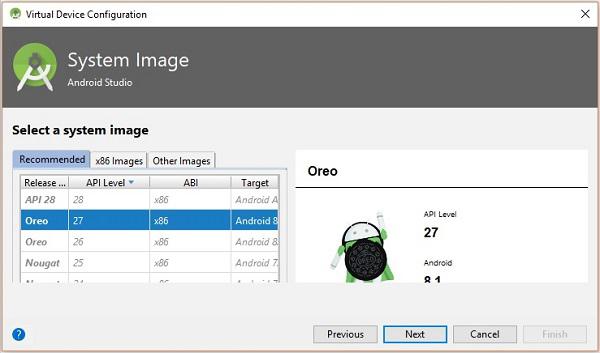
Then, select Marshmallow and click on next.
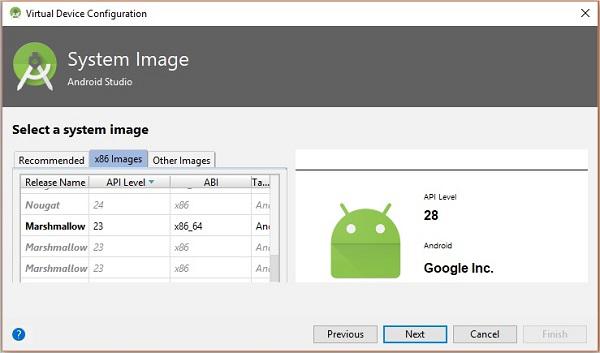
Finally, click on the Finish button to finish the AVD configuration.
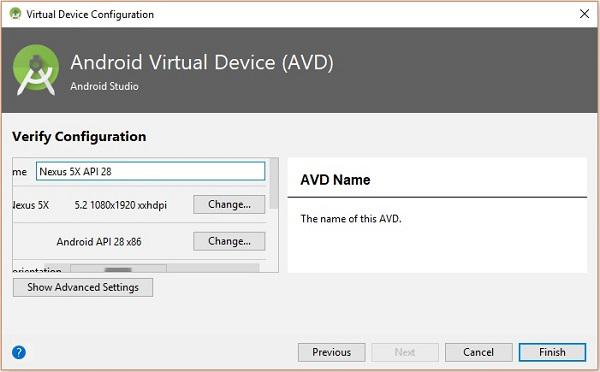
After configuring your virtual device click on the play button under the Actions column to start your android emulator.
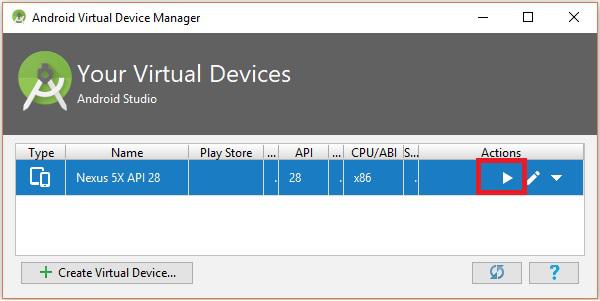
Step 10: Running android
Open command prompt, browse through your project folder and, execute the react-native run-android command.
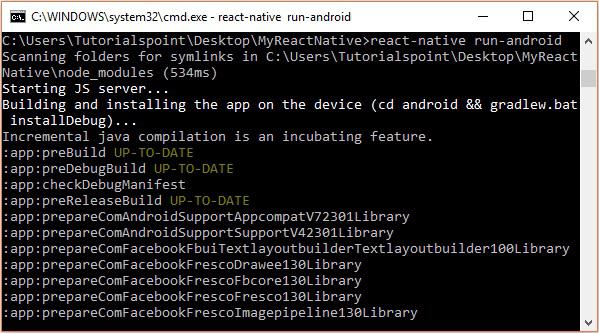
Then, your app execution begins in another prompt you can see its status.
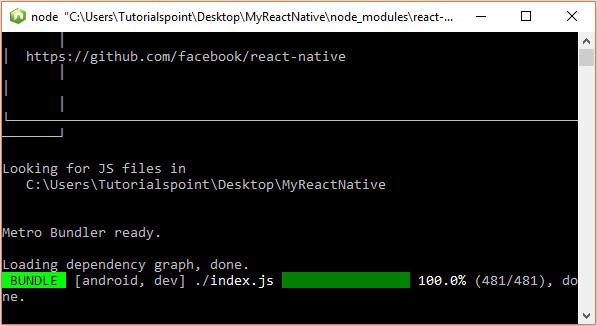
In your android emulator you can see the execution of the default app as −
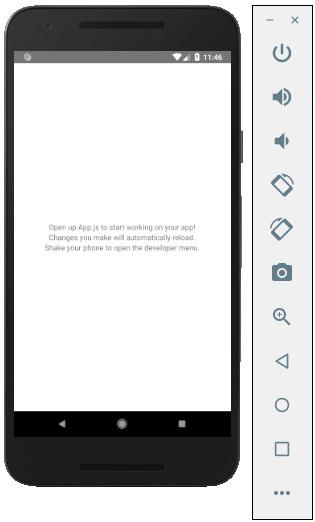
Step 11: local.properties
Open the android folder in your project folder SampleReactNative/android (in this case). Create a file with named local.properties and add the following path in it.
sdk.dir = /C:\\Users\\Howcodex\\AppData\\Local\\Android\\Sdk
here, replace Howcodex with your user name.
Step 12: Hot Reloading
And to build application modify the App.js and the changes will be automatically updated on the android emulator.
If not, click on the android emulator press ctrl+m then, select Enable Hot Reloading option.
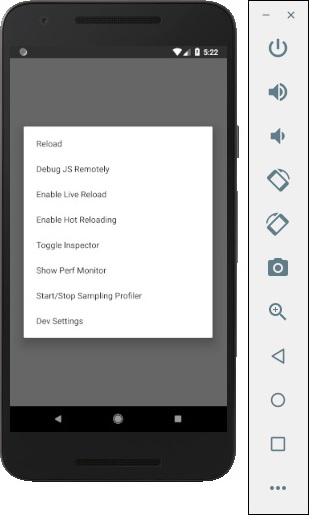
React Native - App
If you open the default app you can observe that the app.js file looks like
import React from 'react';
import { StyleSheet, Text, View } from 'react-native';
export default class App extends React.Component {
render() {
return (
<View style = {styles.container}>
<Text>Open up App.js to start working on your app!</Text>
<Text>Changes you make will automatically reload.</Text>
<Text>Shake your phone to open the developer menu.</Text>
</View>
);
}
}
const styles = StyleSheet.create({
container: {
flex: 1,
backgroundColor: '#fff',
alignItems: 'center',
justifyContent: 'center',
},
});
Output

Hello world
To display a simple message saying “Welcome to Howcodex” remove the CSS part and insert the message to be printed wrapped by the <text></text> tags inside <view></view> as shown below.
import React from 'react';
import { StyleSheet, Text, View } from 'react-native';
export default class App extends React.Component {
render() {
return (
<View>
<Text>Welcome to Howcodex</Text>
</View>
);
}
}
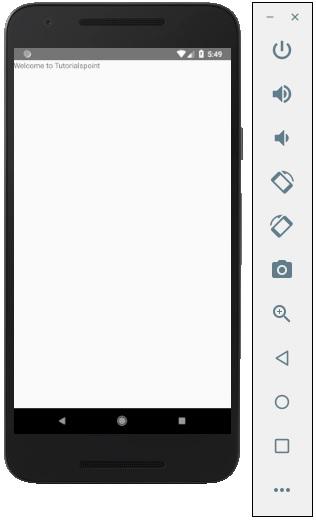
React Native - State
The data inside React Components is managed by state and props. In this chapter, we will talk about state.
Difference between State and Props
The state is mutable while props are immutable. This means that state can be updated in the future while props cannot be updated.
Using State
This is our root component. We are just importing Home which will be used in most of the chapters.
App.js
import React from 'react';
import { StyleSheet, Text, View } from 'react-native';
export default class App extends React.Component {
state = {
myState: 'Lorem ipsum dolor sit amet, consectetur adipisicing elit, used do eiusmod
tempor incididunt ut labore et dolore magna aliqua. Ut enim ad minim veniam, quis
nostrud exercitation ullamco laboris nisi ut aliquip ex ea commodo consequat.
Duis aute irure dolor in reprehenderit in voluptate velit esse cillum dolore eu
fugiat nulla pariatur. Excepteur sint occaecat cupidatat non proident, sunt in
culpa qui officia deserunt mollit anim id est laborum.'
}
render() {
return (
<View>
<Text> {this.state.myState} </Text>
</View>
);
}
}
We can see in emulator text from the state as in the following screenshot.
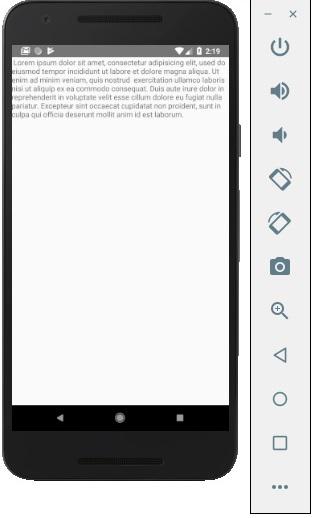
Updating State
Since state is mutable, we can update it by creating the deleteState function and call it using the onPress = {this.deleteText} event.
Home.js
import React, { Component } from 'react'
import { Text, View } from 'react-native'
class Home extends Component {
state = {
myState: 'Lorem ipsum dolor sit amet, consectetur adipisicing elit, sed
do eiusmod tempor incididunt ut labore et dolore magna aliqua.
Ut enim ad minim veniam, quis nostrud exercitation ullamco laboris nisi
ut aliquip ex ea commodo consequat. Duis aute irure dolor in reprehenderit
in voluptate velit esse cillum dolore eu fugiat nulla pariatur.
Excepteur sint occaecat cupidatat non proident, sunt in culpa qui officia
deserunt mollit anim id est laborum.'
}
updateState = () ⇒ this.setState({ myState: 'The state is updated' })
render() {
return (
<View>
<Text onPress = {this.updateState}>
{this.state.myState}
</Text>
</View>
);
}
}
export default Home;
NOTES − In all chapters, we will use the class syntax for stateful (container) components and function syntax for stateless (presentational) components. We will learn more about components in the next chapter.
We will also learn how to use the arrow function syntax for updateState. You should keep in mind that this syntax uses the lexical scope, and this keyword will be bound to the environment object (Class). This will sometimes lead to unexpected behavior.
The other way to define methods is to use the EC5 functions but in that case we will need to bind this manually in the constructor. Consider the following example to understand this.
class Home extends Component {
constructor() {
super()
this.updateState = this.updateState.bind(this)
}
updateState() {
//
}
render() {
//
}
}
React Native - Props
In our last chapter, we showed you how to use mutable state. In this chapter, we will show you how to combine the state and the props.
Presentational components should get all data by passing props. Only container components should have state.
Container Component
We will now understand what a container component is and also how it works.
Theory
Now we will update our container component. This component will handle the state and pass the props to the presentational component.
Container component is only used for handling state. All functionality related to view(styling etc.) will be handled in the presentational component.
Example
If we want to use example from the last chapter we need to remove the Text element from the render function since this element is used for presenting text to the users. This should be inside the presentational component.
Let us review the code in the example given below. We will import the PresentationalComponent and pass it to the render function.
After we import the PresentationalComponent and pass it to the render function, we need to pass the props. We will pass the props by adding myText = {this.state.myText} and deleteText = {this.deleteText} to <PresentationalComponent>. Now, we will be able to access this inside the presentational component.
App.js
import React from 'react';
import { StyleSheet, Text, View } from 'react-native';
import PresentationalComponent from './PresentationalComponent'
export default class App extends React.Component {
state = {
myState: 'Lorem ipsum dolor sit amet, consectetur adipisicing elit, used do eiusmod
tempor incididunt ut labore et dolore magna aliqua. Ut enim ad minim veniam, quis
nostrud exercitation ullamco laboris nisi ut aliquip ex ea commodo consequat. Duis
aute irure dolor in reprehenderit in voluptate velit esse cillum dolore eu fugiat
nulla pariatur. Excepteur sint occaecat cupidatat non proident, sunt in culpa qui
officia deserunt mollit anim id est laborum.'
}
updateState = () => {
this.setState({ myState: 'The state is updated' })
}
render() {
return (
<View>
<PresentationalComponent myState = {this.state.myState} updateState = {this.updateState}/>
</View>
);
}
}
Presentational Component
We will now understand what a presentational component is and also how it works.
Theory
Presentational components should be used only for presenting view to the users. These components do not have state. They receive all data and functions as props.
The best practice is to use as much presentational components as possible.
Example
As we mentioned in our previous chapter, we are using the EC6 function syntax for presentational components.
Our component will receive props, return view elements, present text using {props.myText} and call the {props.deleteText} function when a user clicks on the text.
PresentationalComponent.js
import React, { Component } from 'react'
import { Text, View } from 'react-native'
const PresentationalComponent = (props) => {
return (
<View>
<Text onPress = {props.updateState}>
{props.myState}
</Text>
</View>
)
}
export default PresentationalComponent
Now, we have the same functionality as in our State chapter. The only difference is that we refactored our code to the container and the presentational component.
You can run the app and see the text as in the following screenshot.

If you click on text, it will be removed from the screen.
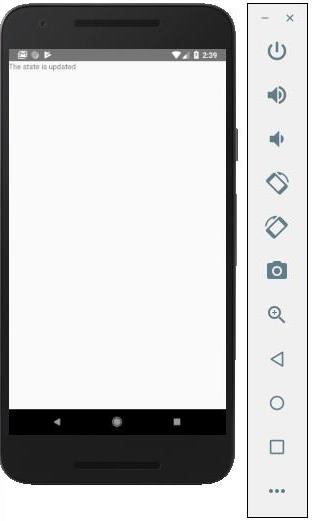
React Native - Styling
There are a couple of ways to style your elements in React Native.
You can use the style property to add the styles inline. However, this is not the best practice because it can be hard to read the code.
In this chapter, we will use the Stylesheet for styling.
Container Component
In this section, we will simplify our container component from our previous chapter.
App.js
import React from 'react';
import { StyleSheet, Text, View } from 'react-native';
import PresentationalComponent from './PresentationalComponent'
export default class App extends React.Component {
state = {
myState: 'This is my state'
}
render() {
return (
<View>
<PresentationalComponent myState = {this.state.myState}/>
</View>
);
}
}
Presentational Component
In the following example, we will import the StyleSheet. At the bottom of the file, we will create our stylesheet and assign it to the styles constant. Note that our styles are in camelCase and we do not use px or % for styling.
To apply styles to our text, we need to add style = {styles.myText} property to the Text element.
PresentationalComponent.js
import React, { Component } from 'react'
import { Text, View, StyleSheet } from 'react-native'
const PresentationalComponent = (props) => {
return (
<View>
<Text style = {styles.myState}>
{props.myState}
</Text>
</View>
)
}
export default PresentationalComponent
const styles = StyleSheet.create ({
myState: {
marginTop: 20,
textAlign: 'center',
color: 'blue',
fontWeight: 'bold',
fontSize: 20
}
})
When we run the app, we will receive the following output.
React Native - Flexbox
To accommodate different screen sizes, React Native offers Flexbox support.
We will use the same code that we used in our React Native - Styling chapter. We will only change the PresentationalComponent.
Layout
To achieve the desired layout, flexbox offers three main properties − flexDirection justifyContent and alignItems.
The following table shows the possible options.
| Property |
Values |
Description |
| flexDirection |
'column', 'row' |
Used to specify if elements will be aligned vertically or horizontally. |
| justifyContent |
'center', 'flex-start', 'flex-end', 'space-around', 'space-between' |
Used to determine how should elements be distributed inside the container. |
| alignItems |
'center', 'flex-start', 'flex-end', 'stretched' |
Used to determine how should elements be distributed inside the container along the secondary axis (opposite of flexDirection) |
If you want to align the items vertically and centralize them, then you can use the following code.
App.js
import React, { Component } from 'react'
import { View, StyleSheet } from 'react-native'
const Home = (props) => {
return (
<View style = {styles.container}>
<View style = {styles.redbox} />
<View style = {styles.bluebox} />
<View style = {styles.blackbox} />
</View>
)
}
export default Home
const styles = StyleSheet.create ({
container: {
flexDirection: 'column',
justifyContent: 'center',
alignItems: 'center',
backgroundColor: 'grey',
height: 600
},
redbox: {
width: 100,
height: 100,
backgroundColor: 'red'
},
bluebox: {
width: 100,
height: 100,
backgroundColor: 'blue'
},
blackbox: {
width: 100,
height: 100,
backgroundColor: 'black'
},
})
Output
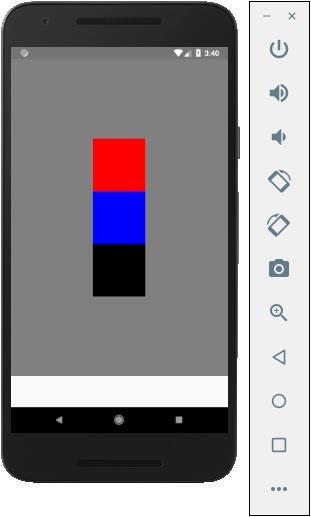
If the items need to be moved to the right side and spaces need to be added between them, then we can use the following code.
App.js
import React, { Component } from 'react'
import { View, StyleSheet } from 'react-native'
const App = (props) => {
return (
<View style = {styles.container}>
<View style = {styles.redbox} />
<View style = {styles.bluebox} />
<View style = {styles.blackbox} />
</View>
)
}
export default App
const styles = StyleSheet.create ({
container: {
flexDirection: 'column',
justifyContent: 'space-between',
alignItems: 'flex-end',
backgroundColor: 'grey',
height: 600
},
redbox: {
width: 100,
height: 100,
backgroundColor: 'red'
},
bluebox: {
width: 100,
height: 100,
backgroundColor: 'blue'
},
blackbox: {
width: 100,
height: 100,
backgroundColor: 'black'
},
})
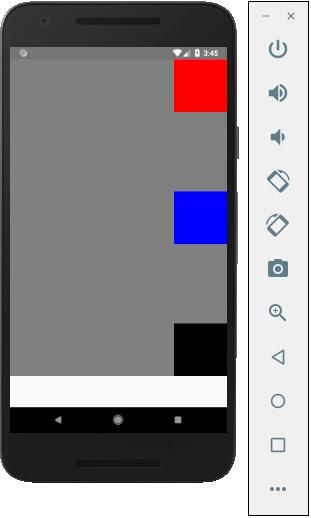
React Native - ListView
In this chapter, we will show you how to create a list in React Native. We will import List in our Home component and show it on screen.
App.js
import React from 'react'
import List from './List.js'
const App = () => {
return (
<List />
)
}
export default App
To create a list, we will use the map() method. This will iterate over an array of items, and render each one.
List.js
import React, { Component } from 'react'
import { Text, View, TouchableOpacity, StyleSheet } from 'react-native'
class List extends Component {
state = {
names: [
{
id: 0,
name: 'Ben',
},
{
id: 1,
name: 'Susan',
},
{
id: 2,
name: 'Robert',
},
{
id: 3,
name: 'Mary',
}
]
}
alertItemName = (item) => {
alert(item.name)
}
render() {
return (
<View>
{
this.state.names.map((item, index) => (
<TouchableOpacity
key = {item.id}
style = {styles.container}
onPress = {() => this.alertItemName(item)}>
<Text style = {styles.text}>
{item.name}
</Text>
</TouchableOpacity>
))
}
</View>
)
}
}
export default List
const styles = StyleSheet.create ({
container: {
padding: 10,
marginTop: 3,
backgroundColor: '#d9f9b1',
alignItems: 'center',
},
text: {
color: '#4f603c'
}
})
When we run the app, we will see the list of names.

You can click on each item in the list to trigger an alert with the name.
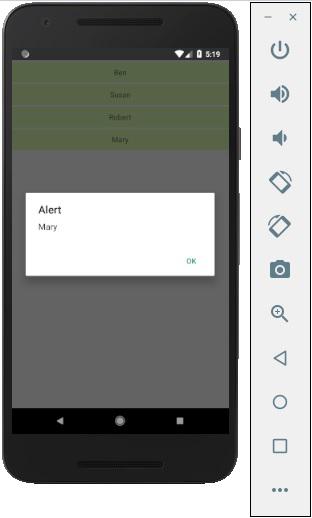
React Native - Text Input
In this chapter, we will show you how to work with TextInput elements in React Native.
The Home component will import and render inputs.
App.js
import React from 'react';
import Inputs from './inputs.js'
const App = () => {
return (
<Inputs />
)
}
export default App
Inputs
We will define the initial state.
After defining the initial state, we will create the handleEmail and the handlePassword functions. These functions are used for updating state.
The login() function will just alert the current value of the state.
We will also add some other properties to text inputs to disable auto capitalisation, remove the bottom border on Android devices and set a placeholder.
inputs.js
import React, { Component } from 'react'
import { View, Text, TouchableOpacity, TextInput, StyleSheet } from 'react-native'
class Inputs extends Component {
state = {
email: '',
password: ''
}
handleEmail = (text) => {
this.setState({ email: text })
}
handlePassword = (text) => {
this.setState({ password: text })
}
login = (email, pass) => {
alert('email: ' + email + ' password: ' + pass)
}
render() {
return (
<View style = {styles.container}>
<TextInput style = {styles.input}
underlineColorAndroid = "transparent"
placeholder = "Email"
placeholderTextColor = "#9a73ef"
autoCapitalize = "none"
onChangeText = {this.handleEmail}/>
<TextInput style = {styles.input}
underlineColorAndroid = "transparent"
placeholder = "Password"
placeholderTextColor = "#9a73ef"
autoCapitalize = "none"
onChangeText = {this.handlePassword}/>
<TouchableOpacity
style = {styles.submitButton}
onPress = {
() => this.login(this.state.email, this.state.password)
}>
<Text style = {styles.submitButtonText}> Submit </Text>
</TouchableOpacity>
</View>
)
}
}
export default Inputs
const styles = StyleSheet.create({
container: {
paddingTop: 23
},
input: {
margin: 15,
height: 40,
borderColor: '#7a42f4',
borderWidth: 1
},
submitButton: {
backgroundColor: '#7a42f4',
padding: 10,
margin: 15,
height: 40,
},
submitButtonText:{
color: 'white'
}
})
Whenever we type in one of the input fields, the state will be updated. When we click on the Submit button, text from inputs will be shown inside the dialog box.
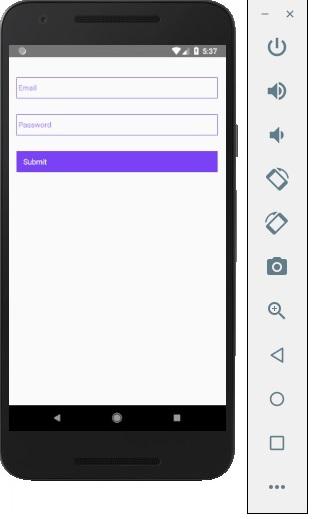
Whenever we type in one of the input fields, the state will be updated. When we click on the Submit button, text from inputs will be shown inside the dialog box.

React Native - ScrollView
In this chapter, we will show you how to work with the ScrollView element.
We will again create ScrollViewExample.js and import it in Home.
App.js
import React from 'react';
import ScrollViewExample from './scroll_view.js';
const App = () => {
return (
<ScrollViewExample />
)
}export default App
Scrollview will render a list of names. We will create it in state.
ScrollView.js
import React, { Component } from 'react';
import { Text, Image, View, StyleSheet, ScrollView } from 'react-native';
class ScrollViewExample extends Component {
state = {
names: [
{'name': 'Ben', 'id': 1},
{'name': 'Susan', 'id': 2},
{'name': 'Robert', 'id': 3},
{'name': 'Mary', 'id': 4},
{'name': 'Daniel', 'id': 5},
{'name': 'Laura', 'id': 6},
{'name': 'John', 'id': 7},
{'name': 'Debra', 'id': 8},
{'name': 'Aron', 'id': 9},
{'name': 'Ann', 'id': 10},
{'name': 'Steve', 'id': 11},
{'name': 'Olivia', 'id': 12}
]
}
render() {
return (
<View>
<ScrollView>
{
this.state.names.map((item, index) => (
<View key = {item.id} style = {styles.item}>
<Text>{item.name}</Text>
</View>
))
}
</ScrollView>
</View>
)
}
}
export default ScrollViewExample
const styles = StyleSheet.create ({
item: {
flexDirection: 'row',
justifyContent: 'space-between',
alignItems: 'center',
padding: 30,
margin: 2,
borderColor: '#2a4944',
borderWidth: 1,
backgroundColor: '#d2f7f1'
}
})
When we run the app, we will see the scrollable list of names.
React Native - Images
In this chapter, we will understand how to work with images in React Native.
Adding Image
Let us create a new folder img inside the src folder. We will add our image (myImage.png) inside this folder.
We will show images on the home screen.
App.js
import React from 'react';
import ImagesExample from './ImagesExample.js'
const App = () => {
return (
<ImagesExample />
)
}
export default App
Local image can be accessed using the following syntax.
image_example.js
import React, { Component } from 'react'
import { Image } from 'react-native'
const ImagesExample = () => (
<Image source = {require('C:/Users/Howcodex/Desktop/NativeReactSample/logo.png')} />
)
export default ImagesExample
Output
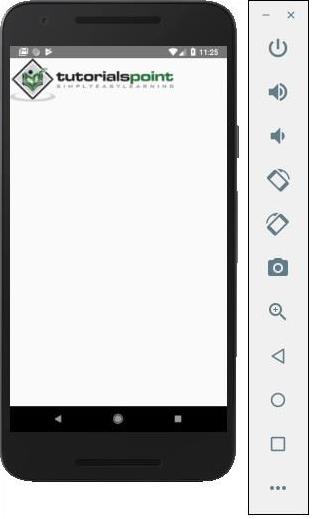
Screen Density
React Native offers a way to optimize images for different devices using @2x, @3x suffix. The app will load only the image necessary for particular screen density.
The following will be the names of the image inside the img folder.
my-image@2x.jpg
my-image@3x.jpg
Network Images
When using network images, instead of require, we need the source property. It is recommended to define the width and the height for network images.
App.js
import React from 'react';
import ImagesExample from './image_example.js'
const App = () => {
return (
<ImagesExample />
)
}
export default App
image_example.js
import React, { Component } from 'react'
import { View, Image } from 'react-native'
const ImagesExample = () => (
<Image source = {{uri:'https://pbs.twimg.com/profile_images/486929358120964097/gNLINY67_400x400.png'}}
style = {{ width: 200, height: 200 }}
/>
)
export default ImagesExample
Output
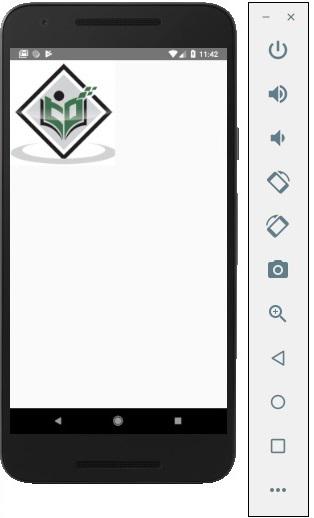
React Native - HTTP
In this chapter, we will show you how to use fetch for handling network requests.
App.js
import React from 'react';
import HttpExample from './http_example.js'
const App = () => {
return (
<HttpExample />
)
}
export default App
Using Fetch
We will use the componentDidMount lifecycle method to load the data from server as soon as the component is mounted. This function will send GET request to the server, return JSON data, log output to console and update our state.
http_example.js
import React, { Component } from 'react'
import { View, Text } from 'react-native'
class HttpExample extends Component {
state = {
data: ''
}
componentDidMount = () => {
fetch('https://jsonplaceholder.typicode.com/posts/1', {
method: 'GET'
})
.then((response) => response.json())
.then((responseJson) => {
console.log(responseJson);
this.setState({
data: responseJson
})
})
.catch((error) => {
console.error(error);
});
}
render() {
return (
<View>
<Text>
{this.state.data.body}
</Text>
</View>
)
}
}
export default HttpExample
Output
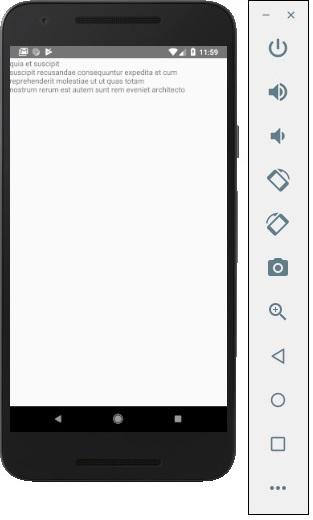
React Native - Buttons
In this chapter, we will show you touchable components in react Native. We call them 'touchable' because they offer built in animations and we can use the onPress prop for handling touch event.
Facebook offers the Button component, which can be used as a generic button. Consider the following example to understand the same.
App.js
import React, { Component } from 'react'
import { Button } from 'react-native'
const App = () => {
const handlePress = () => false
return (
<Button
onPress = {handlePress}
title = "Red button!"
color = "red"
/>
)
}
export default App
If the default Button component does not suit your needs, you can use one of the following components instead.
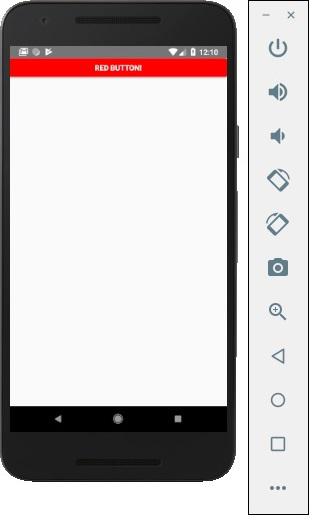
Touchable Opacity
This element will change the opacity of an element when touched.
App.js
import React from 'react'
import { TouchableOpacity, StyleSheet, View, Text } from 'react-native'
const App = () => {
return (
<View style = {styles.container}>
<TouchableOpacity>
<Text style = {styles.text}>
Button
</Text>
</TouchableOpacity>
</View>
)
}
export default App
const styles = StyleSheet.create ({
container: {
alignItems: 'center',
},
text: {
borderWidth: 1,
padding: 25,
borderColor: 'black',
backgroundColor: 'red'
}
})
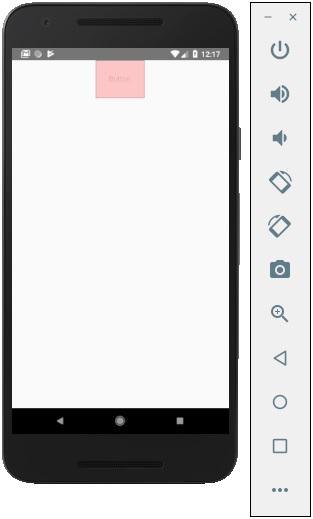
Touchable Highlight
When a user presses the element, it will get darker and the underlying color will show through.
App.js
import React from 'react'
import { View, TouchableHighlight, Text, StyleSheet } from 'react-native'
const App = (props) => {
return (
<View style = {styles.container}>
<TouchableHighlight>
<Text style = {styles.text}>
Button
</Text>
</TouchableHighlight>
</View>
)
}
export default App
const styles = StyleSheet.create ({
container: {
alignItems: 'center',
},
text: {
borderWidth: 1,
padding: 25,
borderColor: 'black',
backgroundColor: 'red'
}
})
Touchable Native Feedback
This will simulate ink animation when the element is pressed.
App.js
import React from 'react'
import { View, TouchableNativeFeedback, Text, StyleSheet } from 'react-native'
const Home = (props) => {
return (
<View style = {styles.container}>
<TouchableNativeFeedback>
<Text style = {styles.text}>
Button
</Text>
</TouchableNativeFeedback>
</View>
)
}
export default Home
const styles = StyleSheet.create ({
container: {
alignItems: 'center',
},
text: {
borderWidth: 1,
padding: 25,
borderColor: 'black',
backgroundColor: 'red'
}
})
Touchable Without Feedback
This should be used when you want to handle the touch event without any animation Usually, this component is not used much.
<TouchableWithoutFeedback>
<Text>
Button
</Text>
</TouchableWithoutFeedback>
React Native - Animations
In this chapter, we will show you how to use LayoutAnimation in React Native.
Animations Component
We will set myStyle as a property of the state. This property is used for styling an element inside PresentationalAnimationComponent.
We will also create two functions − expandElement and collapseElement. These functions will update values from the state. The first one will use the spring preset animation while the second one will have the linear preset. We will pass these as props too. The Expand and the Collapse buttons call the expandElement() and collapseElement() functions.
In this example, we will dynamically change the width and the height of the box. Since the Home component will be the same, we will only change the Animations component.
App.js
import React, { Component } from 'react'
import { View, StyleSheet, Animated, TouchableOpacity } from 'react-native'
class Animations extends Component {
componentWillMount = () => {
this.animatedWidth = new Animated.Value(50)
this.animatedHeight = new Animated.Value(100)
}
animatedBox = () => {
Animated.timing(this.animatedWidth, {
toValue: 200,
duration: 1000
}).start()
Animated.timing(this.animatedHeight, {
toValue: 500,
duration: 500
}).start()
}
render() {
const animatedStyle = { width: this.animatedWidth, height: this.animatedHeight }
return (
<TouchableOpacity style = {styles.container} onPress = {this.animatedBox}>
<Animated.View style = {[styles.box, animatedStyle]}/>
</TouchableOpacity>
)
}
}
export default Animations
const styles = StyleSheet.create({
container: {
justifyContent: 'center',
alignItems: 'center'
},
box: {
backgroundColor: 'blue',
width: 50,
height: 100
}
})
React Native - Debugging
React native offers a couple of methods that help in debugging your code.
In App Developer Menu
You can open the developer menu on the IOS simulator by pressing command + D.
On Android emulator, you need to press command + M.
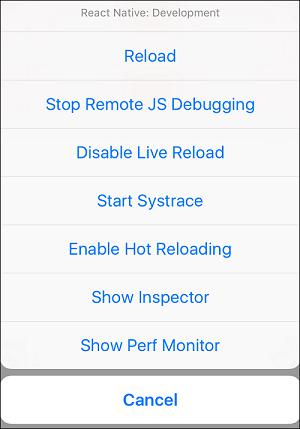
Reload − Used for reloading simulator. You can use shortcut command + R
Debug JS Remotely − Used for activating debugging inside browser developer console.
Enable Live Reload − Used for enabling live reloading whenever your code is saved. The debugger will open at localhost:8081/debugger-ui.
Start Systrace − Used for starting Android marker based profiling tool.
Show Inspector − Used for opening inspector where you can find info about your components. You can use shortcut command + I
Show Perf Monitor − Perf monitor is used for keeping track of the performance of your app.
React Native - Router
In this chapter, we will understand navigation in React Native.
Step 1: Install Router
To begin with, we need to install the Router. We will use the React Native Router Flux in this chapter. You can run the following command in terminal, from the project folder.
npm i react-native-router-flux --save
Step 2: Entire Application
Since we want our router to handle the entire application, we will add it in index.ios.js. For Android, you can do the same in index.android.js.
App.js
import React, { Component } from 'react';
import { AppRegistry, View } from 'react-native';
import Routes from './Routes.js'
class reactTutorialApp extends Component {
render() {
return (
<Routes />
)
}
}
export default reactTutorialApp
AppRegistry.registerComponent('reactTutorialApp', () => reactTutorialApp)
Step 3: Add Router
Now we will create the Routes component inside the components folder. It will return Router with several scenes. Each scene will need key, component and title. Router uses the key property to switch between scenes, component will be rendered on screen and the title will be shown in the navigation bar. We can also set the initial property to the scene that is to be rendered initially.
Routes.js
import React from 'react'
import { Router, Scene } from 'react-native-router-flux'
import Home from './Home.js'
import About from './About.js'
const Routes = () => (
<Router>
<Scene key = "root">
<Scene key = "home" component = {Home} title = "Home" initial = {true} />
<Scene key = "about" component = {About} title = "About" />
</Scene>
</Router>
)
export default Routes
Step 4: Create Components
We already have the Home component from previous chapters; now, we need to add the About component. We will add the goToAbout and the goToHome functions to switch between scenes.
Home.js
import React from 'react'
import { TouchableOpacity, Text } from 'react-native';
import { Actions } from 'react-native-router-flux';
const Home = () => {
const goToAbout = () => {
Actions.about()
}
return (
<TouchableOpacity style = {{ margin: 128 }} onPress = {goToAbout}>
<Text>This is HOME!</Text>
</TouchableOpacity>
)
}
export default Home
About.js
import React from 'react'
import { TouchableOpacity, Text } from 'react-native'
import { Actions } from 'react-native-router-flux'
const About = () => {
const goToHome = () => {
Actions.home()
}
return (
<TouchableOpacity style = {{ margin: 128 }} onPress = {goToHome}>
<Text>This is ABOUT</Text>
</TouchableOpacity>
)
}
export default About
The app will render the initial Home screen.
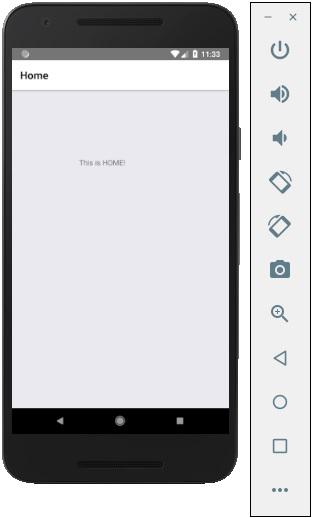
You can press the button to switch to the about screen. The Back arrow will appear; you can use it to get back to the previous screen.
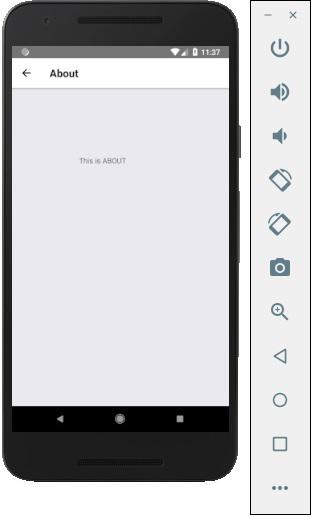
React Native - Running IOS
If you want to test your app in the IOS simulator, all you need is to open the root folder of your app in terminal and run −
react-native run-ios
The above command will start the simulator and run the app.
We can also specify the device we want to use.
react-native run-ios --simulator "iPhone 5s
After you open the app in simulator, you can press command + D on IOS to open the developers menu. You can check more about this in our debugging chapter.
You can also reload the IOS simulator by pressing command + R.
React Native - Running Android
We can run the React Native app on Android platform by running the following code in the terminal.
react-native run-android
Before you can run your app on Android device, you need to enable USB Debugging inside the Developer Options.
When USB Debugging is enabled, you can plug in your device and run the code snippet given above.
The Native Android emulator is slow. We recommend downloading Genymotion for testing your app.
The developer menu can be accessed by pressing command + M.
React Native - View
View is the most common element in React Native. You can consider it as an equivalent of the div element used in web development.
Use Cases
Let us now see a few common use cases.
When you need to wrap your elements inside the container, you can use View as a container element.
When you want to nest more elements inside the parent element, both parent and child can be View. It can have as many children as you want.
When you want to style different elements, you can place them inside View since it supports style property, flexbox etc.
View also supports synthetic touch events, which can be useful for different purposes.
We already used View in our previous chapters and we will use it in almost all subsequent chapters as well. The View can be assumed as a default element in React Native. In example given below, we will nest two Views and a text.
App.js
import React, { Component } from 'react'
import { View, Text } from 'react-native'
const App = () => {
return (
<View>
<View>
<Text>This is my text</Text>
</View>
</View>
)
}
export default App
Output
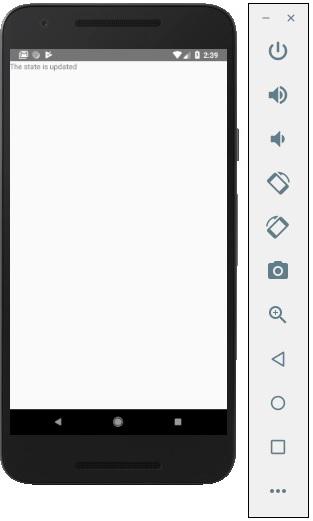
React Native - WebView
In this chapter, we will learn how to use WebView. It is used when you want to render web page to your mobile app inline.
Using WebView
The HomeContainer will be a container component.
App.js
import React, { Component } from 'react'
import WebViewExample from './web_view_example.js'
const App = () => {
return (
<WebViewExample/>
)
}
export default App;
Let us create a new file called WebViewExample.js inside the src/components/home folder.
web_view_example.js
import React, { Component } from 'react'
import { View, WebView, StyleSheet }
from 'react-native'
const WebViewExample = () => {
return (
<View style = {styles.container}>
<WebView
source = {{ uri:
'https://www.google.com/?gws_rd=cr,ssl&ei=SICcV9_EFqqk6ASA3ZaABA#q=howcodex' }}
/>
</View>
)
}
export default WebViewExample;
const styles = StyleSheet.create({
container: {
height: 350,
}
})
The above program will generate the following output.

React Native - Modal
In this chapter, we will show you how to use the modal component in React Native.
Let us now create a new file: ModalExample.js
We will put logic inside ModalExample. We can update the initial state by running the toggleModal.
After updating the initial state by running the toggleModal, we will set the visible property to our modal. This prop will be updated when the state changes.
The onRequestClose is required for Android devices.
App.js
import React, { Component } from 'react'
import WebViewExample from './modal_example.js'
const Home = () => {
return (
<WebViewExample/>
)
}
export default Home;
modal_example.js
import React, { Component } from 'react';
import { Modal, Text, TouchableHighlight, View, StyleSheet}
from 'react-native'
class ModalExample extends Component {
state = {
modalVisible: false,
}
toggleModal(visible) {
this.setState({ modalVisible: visible });
}
render() {
return (
<View style = {styles.container}>
<Modal animationType = {"slide"} transparent = {false}
visible = {this.state.modalVisible}
onRequestClose = {() => { console.log("Modal has been closed.") } }>
<View style = {styles.modal}>
<Text style = {styles.text}>Modal is open!</Text>
<TouchableHighlight onPress = {() => {
this.toggleModal(!this.state.modalVisible)}}>
<Text style = {styles.text}>Close Modal</Text>
</TouchableHighlight>
</View>
</Modal>
<TouchableHighlight onPress = {() => {this.toggleModal(true)}}>
<Text style = {styles.text}>Open Modal</Text>
</TouchableHighlight>
</View>
)
}
}
export default ModalExample
const styles = StyleSheet.create ({
container: {
alignItems: 'center',
backgroundColor: '#ede3f2',
padding: 100
},
modal: {
flex: 1,
alignItems: 'center',
backgroundColor: '#f7021a',
padding: 100
},
text: {
color: '#3f2949',
marginTop: 10
}
})
Our starting screen will look like this −
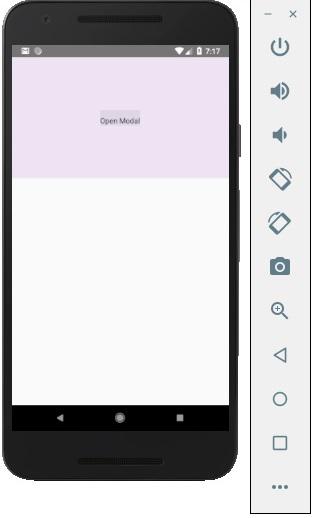
If we click the button, the modal will open.
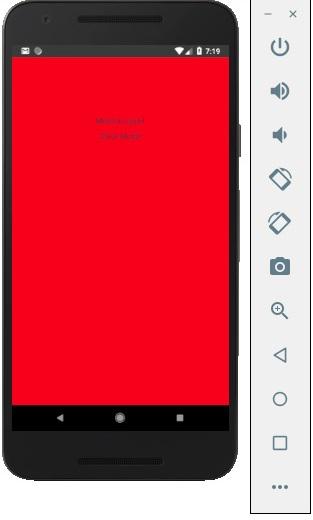
React Native - ActivityIndicator
In this chapter we will show you how to use the activity indicator in React Native.
Step 1: App
App component will be used to import and show our ActivityIndicator.
App.js
import React from 'react'
import ActivityIndicatorExample from './activity_indicator_example.js'
const Home = () => {
return (
<ActivityIndicatorExample />
)
}
export default Home
Step 2: ActivityIndicatorExample
Animating property is a Boolean which is used for showing the activity indicator. The latter closes six seconds after the component is mounted. This is done using the closeActivityIndicator() function.
activity_indicator_example.js
import React, { Component } from 'react';
import { ActivityIndicator, View, Text, TouchableOpacity, StyleSheet } from 'react-native';
class ActivityIndicatorExample extends Component {
state = { animating: true }
closeActivityIndicator = () => setTimeout(() => this.setState({
animating: false }), 60000)
componentDidMount = () => this.closeActivityIndicator()
render() {
const animating = this.state.animating
return (
<View style = {styles.container}>
<ActivityIndicator
animating = {animating}
color = '#bc2b78'
size = "large"
style = {styles.activityIndicator}/>
</View>
)
}
}
export default ActivityIndicatorExample
const styles = StyleSheet.create ({
container: {
flex: 1,
justifyContent: 'center',
alignItems: 'center',
marginTop: 70
},
activityIndicator: {
flex: 1,
justifyContent: 'center',
alignItems: 'center',
height: 80
}
})
When we run the app, we will see the loader on screen. It will disappear after six seconds.
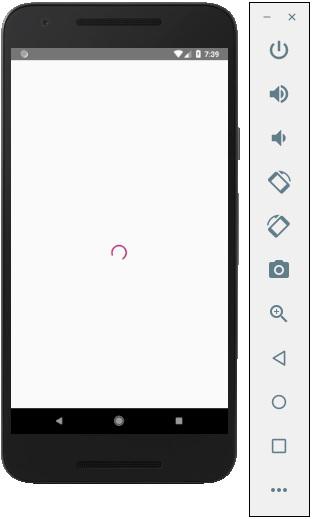
React Native - Picker
In this chapter, we will create simple Picker with two available options.
Step 1: Create File
Here, the App.js folder will be used as a presentational component.
App.js
import React from 'react'
import PickerExample from './PickerExample.js'
const App = () => {
return (
<PickerExample />
)
}
export default App
Step 2: Logic
this.state.user is used for picker control.
The updateUser function will be triggered when a user is picked.
PickerExample.js
import React, { Component } from 'react';
import { View, Text, Picker, StyleSheet } from 'react-native'
class PickerExample extends Component {
state = {user: ''}
updateUser = (user) => {
this.setState({ user: user })
}
render() {
return (
<View>
<Picker selectedValue = {this.state.user} onValueChange = {this.updateUser}>
<Picker.Item label = "Steve" value = "steve" />
<Picker.Item label = "Ellen" value = "ellen" />
<Picker.Item label = "Maria" value = "maria" />
</Picker>
<Text style = {styles.text}>{this.state.user}</Text>
</View>
)
}
}
export default PickerExample
const styles = StyleSheet.create({
text: {
fontSize: 30,
alignSelf: 'center',
color: 'red'
}
})
Output
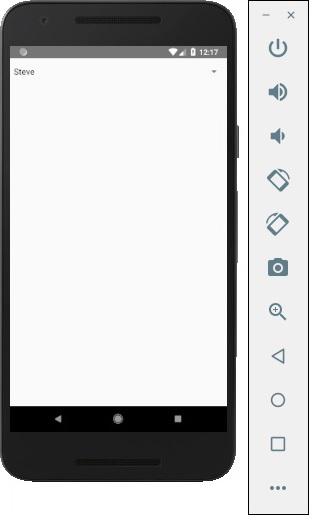
If you click on the name it prompts you all three options as −
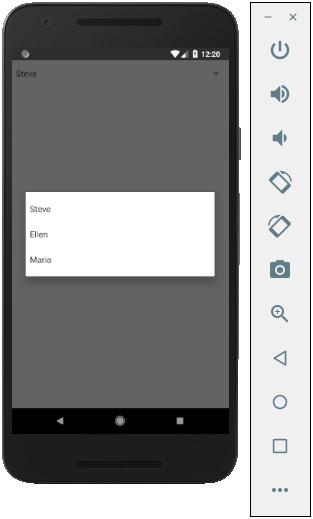
And you can pick one of them and the output will be like.
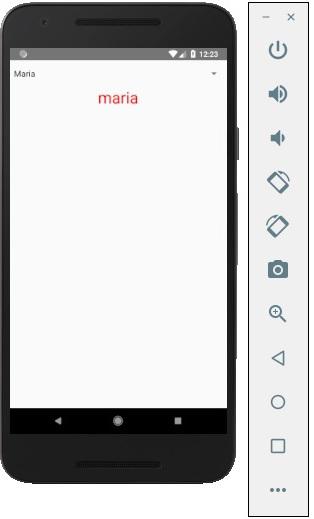
React Native - Status Bar
In this chapter, we will show you how to control the status bar appearance in React Native.
The Status bar is easy to use and all you need to do is set properties to change it.
The hidden property can be used to hide the status bar. In our example it is set to false. This is default value.
The barStyle can have three values – dark-content, light-content and default.
This component has several other properties that can be used. Some of them are Android or IOS specific. You can check it in official documentation.
App.js
import React, { Component } from 'react';
import { StatusBar } from 'react-native'
const App = () => {
return (
<StatusBar barStyle = "dark-content" hidden = {false} backgroundColor = "#00BCD4" translucent = {true}/>
)
}
export default App
If we run the app, the status bar will be visible and content will have dark color.
Output
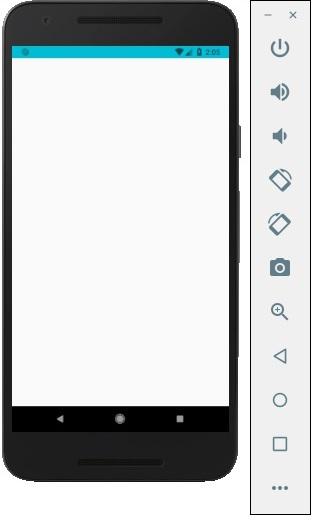
React Native - Switch
In this chapter, we will explain the Switch component in a couple of steps.
Step 1: Create File
We will use the HomeContainer component for logic, but we need to create the presentational component.
Let us now create a new file: SwitchExample.js.
Step 2: Logic
We are passing value from the state and functions for toggling switch items to SwitchExample component. Toggle functions will be used for updating the state.
App.js
import React, { Component } from 'react'
import { View } from 'react-native'
import SwitchExample from './switch_example.js'
export default class HomeContainer extends Component {
constructor() {
super();
this.state = {
switch1Value: false,
}
}
toggleSwitch1 = (value) => {
this.setState({switch1Value: value})
console.log('Switch 1 is: ' + value)
}
render() {
return (
<View>
<SwitchExample
toggleSwitch1 = {this.toggleSwitch1}
switch1Value = {this.state.switch1Value}/>
</View>
);
}
}
Step 3: Presentation
Switch component takes two props. The onValueChange prop will trigger our toggle functions after a user presses the switch. The value prop is bound to the state of the HomeContainer component.
switch_example.js
import React, { Component } from 'react'
import { View, Switch, StyleSheet }
from 'react-native'
export default SwitchExample = (props) => {
return (
<View style = {styles.container}>
<Switch
onValueChange = {props.toggleSwitch1}
value = {props.switch1Value}/>
</View>
)
}
const styles = StyleSheet.create ({
container: {
flex: 1,
alignItems: 'center',
marginTop: 100
}
})
If we press the switch, the state will be updated. You can check values in the console.
Output
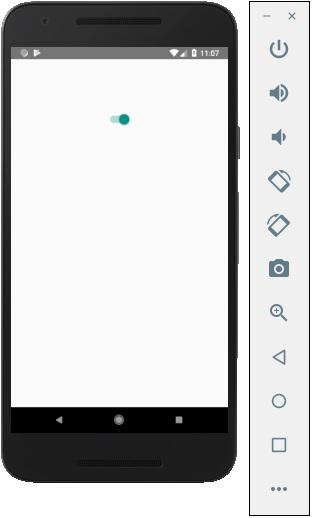
React Native - Text
In this chapter, we will talk about Text component in React Native.
This component can be nested and it can inherit properties from parent to child. This can be useful in many ways. We will show you example of capitalizing the first letter, styling words or parts of the text, etc.
Step 1: Create File
The file we are going to create is text_example.js
Step 2: App.js
In this step, we will just create a simple container.
App.js
import React, { Component } from 'react'
import TextExample from './text_example.js'
const App = () => {
return (
<TextExample/>
)
}
export default App
Step 3: Text
In this step, we will use the inheritance pattern. styles.text will be applied to all Text components.
You can also notice how we set other styling properties to some parts of the text. It is important to know that all child elements have parent styles passed to them.
text_example.js
import React, { Component } from 'react';
import { View, Text, Image, StyleSheet } from 'react-native'
const TextExample = () => {
return (
<View style = {styles.container}>
<Text style = {styles.text}>
<Text style = {styles.capitalLetter}>
L
</Text>
<Text>
orem ipsum dolor sit amet, sed do eiusmod.
</Text>
<Text>
Ut enim ad <Text style = {styles.wordBold}>minim </Text> veniam,
quis aliquip ex ea commodo consequat.
</Text>
<Text style = {styles.italicText}>
Duis aute irure dolor in reprehenderit in voluptate velit esse cillum.
</Text>
<Text style = {styles.textShadow}>
Excepteur sint occaecat cupidatat non proident, sunt in culpa qui officia
deserunt mollit anim id est laborum.
</Text>
</Text>
</View>
)
}
export default TextExample
const styles = StyleSheet.create ({
container: {
alignItems: 'center',
marginTop: 100,
padding: 20
},
text: {
color: '#41cdf4',
},
capitalLetter: {
color: 'red',
fontSize: 20
},
wordBold: {
fontWeight: 'bold',
color: 'black'
},
italicText: {
color: '#37859b',
fontStyle: 'italic'
},
textShadow: {
textShadowColor: 'red',
textShadowOffset: { width: 2, height: 2 },
textShadowRadius : 5
}
})
You will receive the following output −
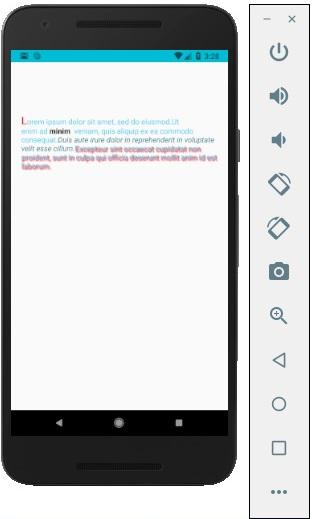
React Native - Alert
In this chapter, we will understand how to create custom Alert component.
Step 1: App.js
import React from 'react'
import AlertExample from './alert_example.js'
const App = () => {
return (
<AlertExample />
)
}
export default App
Step 2: alert_example.js
We will create a button for triggering the showAlert function.
import React from 'react'
import { Alert, Text, TouchableOpacity, StyleSheet } from 'react-native'
const AlertExample = () => {
const showAlert = () =>{
Alert.alert(
'You need to...'
)
}
return (
<TouchableOpacity onPress = {showAlert} style = {styles.button}>
<Text>Alert</Text>
</TouchableOpacity>
)
}
export default AlertExample
const styles = StyleSheet.create ({
button: {
backgroundColor: '#4ba37b',
width: 100,
borderRadius: 50,
alignItems: 'center',
marginTop: 100
}
})
Output
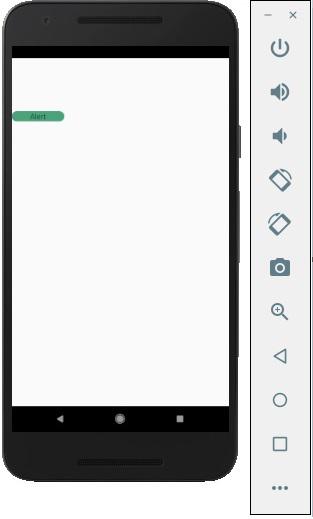
When you click the button, you will see the following −

React Native - Geolocation
In this chapter, we will show you how to use Geolocation.
Step 1: App.js
import React from 'react'
import GeolocationExample from './geolocation_example.js'
const App = () => {
return (
<GeolocationExample />
)
}
export default App
Step 2: Geolocation
We will start by setting up the initial state for that will hold the initial and the last position.
Now, we need to get current position of the device when a component is mounted using the navigator.geolocation.getCurrentPosition. We will stringify the response so we can update the state.
navigator.geolocation.watchPosition is used for tracking the users’ position. We also clear the watchers in this step.
AsyncStorageExample.js
import React, { Component } from 'react'
import { View, Text, Switch, StyleSheet} from 'react-native'
class SwichExample extends Component {
state = {
initialPosition: 'unknown',
lastPosition: 'unknown',
}
watchID: ?number = null;
componentDidMount = () => {
navigator.geolocation.getCurrentPosition(
(position) => {
const initialPosition = JSON.stringify(position);
this.setState({ initialPosition });
},
(error) => alert(error.message),
{ enableHighAccuracy: true, timeout: 20000, maximumAge: 1000 }
);
this.watchID = navigator.geolocation.watchPosition((position) => {
const lastPosition = JSON.stringify(position);
this.setState({ lastPosition });
});
}
componentWillUnmount = () => {
navigator.geolocation.clearWatch(this.watchID);
}
render() {
return (
<View style = {styles.container}>
<Text style = {styles.boldText}>
Initial position:
</Text>
<Text>
{this.state.initialPosition}
</Text>
<Text style = {styles.boldText}>
Current position:
</Text>
<Text>
{this.state.lastPosition}
</Text>
</View>
)
}
}
export default SwichExample
const styles = StyleSheet.create ({
container: {
flex: 1,
alignItems: 'center',
marginTop: 50
},
boldText: {
fontSize: 30,
color: 'red',
}
})
React Native - AsyncStorage
In this chapter, we will show you how to persist your data using AsyncStorage.
Step 1: Presentation
In this step, we will create the App.js file.
import React from 'react'
import AsyncStorageExample from './async_storage_example.js'
const App = () => {
return (
<AsyncStorageExample />
)
}
export default App
Step 2: Logic
Name from the initial state is empty string. We will update it from persistent storage when the component is mounted.
setName will take the text from our input field, save it using AsyncStorage and update the state.
async_storage_example.js
import React, { Component } from 'react'
import { StatusBar } from 'react-native'
import { AsyncStorage, Text, View, TextInput, StyleSheet } from 'react-native'
class AsyncStorageExample extends Component {
state = {
'name': ''
}
componentDidMount = () => AsyncStorage.getItem('name').then((value) => this.setState({ 'name': value }))
setName = (value) => {
AsyncStorage.setItem('name', value);
this.setState({ 'name': value });
}
render() {
return (
<View style = {styles.container}>
<TextInput style = {styles.textInput} autoCapitalize = 'none'
onChangeText = {this.setName}/>
<Text>
{this.state.name}
</Text>
</View>
)
}
}
export default AsyncStorageExample
const styles = StyleSheet.create ({
container: {
flex: 1,
alignItems: 'center',
marginTop: 50
},
textInput: {
margin: 5,
height: 100,
borderWidth: 1,
backgroundColor: '#7685ed'
}
})
When we run the app, we can update the text by typing into the input field.
